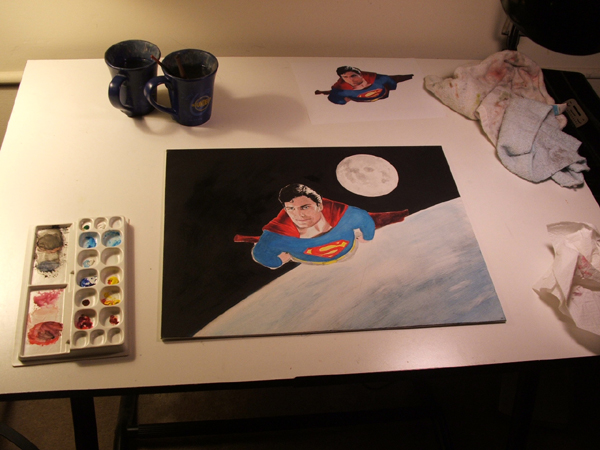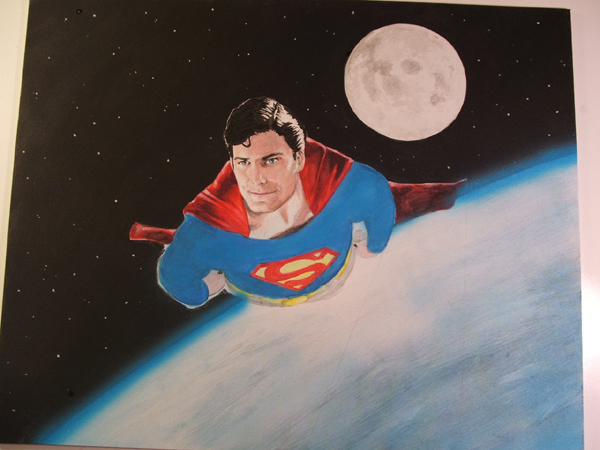 God
damn Alex Ross. Not only
is he blessed with an artistic talent the rest of us can only
dream about, but the guy is able to churn out his brilliant work
FAST. Most of the artwork you see here took me weeks, if not months
to finish. So I decided to give myself a challenge: try to paint
a superhero image using Ross' technique, and do it in less than
two days. I ended up needing three.
God
damn Alex Ross. Not only
is he blessed with an artistic talent the rest of us can only
dream about, but the guy is able to churn out his brilliant work
FAST. Most of the artwork you see here took me weeks, if not months
to finish. So I decided to give myself a challenge: try to paint
a superhero image using Ross' technique, and do it in less than
two days. I ended up needing three.
I made no
hesitation in selecting the subject matter: Christopher Reeve
remains the definitive Superman for the ages. I used two different
photo images, a face portrait and a screenshot of Reeve flying
in SUPERMAN II, and combined them in Photoshop. From this I sketched
the figure onto a watercolor board. Simple enough so far.
 Now
the tricky part. Ross uses gouache, an opaque watercolor paint,
to bring his work to life. I've used them before, but never extensively.
Watercolors usually present a challenge in that it is often difficult
to get "flat" or really solid colors without washing
them out. To my surprise, gouache paints largely rectify this
problem, and you can, if to a limited degree, paint some lighter
colors on top of darker ones.
Now
the tricky part. Ross uses gouache, an opaque watercolor paint,
to bring his work to life. I've used them before, but never extensively.
Watercolors usually present a challenge in that it is often difficult
to get "flat" or really solid colors without washing
them out. To my surprise, gouache paints largely rectify this
problem, and you can, if to a limited degree, paint some lighter
colors on top of darker ones.
Still, I
was flabberghasted when I learned how Ross actually paints his
pictures. He breaks the common law of watercolors by painting
the black and dark layers first. Only then, after a rough
black and white painting is done, does he begin to add the colors!
 Wanting
to stay true to Ross' process, I decide to get the exact same
type of paintbrush Ross uses -- a Winsor & Newton Series 7
Red Sable, Size 4. Much to my chagrin, the brush is bloody expensive;
I spend more on buying it than I do the paints!
Wanting
to stay true to Ross' process, I decide to get the exact same
type of paintbrush Ross uses -- a Winsor & Newton Series 7
Red Sable, Size 4. Much to my chagrin, the brush is bloody expensive;
I spend more on buying it than I do the paints!
Would Ross'
technique work for me? I had no idea. Adding the blacks was almost
always my last step in using watercolors, not the first.
Reversing the process normally would turn the colors all "muddy",
and detail would be lost. But I decided to throw caution to the
wind and give it a try.
 Day
two. I'm beginning to like using this gouache stuff. But I'm having
problems getting used to adding the colors without making them
look too muddy. Painting on a watercolor canvas board instead
of paper is also troublesome -- the board doesn't absorb the paint
as well as paper, but at least I don't have to worry about any
"crinkling."
Day
two. I'm beginning to like using this gouache stuff. But I'm having
problems getting used to adding the colors without making them
look too muddy. Painting on a watercolor canvas board instead
of paper is also troublesome -- the board doesn't absorb the paint
as well as paper, but at least I don't have to worry about any
"crinkling."
I'm impressed
by how you can get some pretty solid colors out of the paint.
To have a solid black background would be pretty tough to paint
in standard watercolor. You can paint a little more thickly with
the gouache, too.
 I
whip out my old airbrush for the first time in two years. I always
get nervous using it, but it is able to give an element of magic
that I otherwise couldn't paint: glowing light effects, color
blends, etc. I try to use it sparingly. In this case, you can
see how I added the blue atmospheric effects to the Earth in the
background.
I
whip out my old airbrush for the first time in two years. I always
get nervous using it, but it is able to give an element of magic
that I otherwise couldn't paint: glowing light effects, color
blends, etc. I try to use it sparingly. In this case, you can
see how I added the blue atmospheric effects to the Earth in the
background.
I use some
masking tape and frisket film to cover the figure while airbrushing
some lighting effects. When done, the "rays" of light
look too harsh and bland -- in other words, they look too airbrushed.
I try to soften the effect by adding some brushstrokes by hand,
giving the overall painting a more consistant style. It doesn't
have to look perfect; with these kinds of paints, seeing the brushstrokes
adds to the charm.
 Day
three. I finish adding details to the suit, and spend a few minutes
adding clouds to the planet below. I guess I could do more, but
I decide to quit while I'm ahead. All in all, the painting took
me about 12 hours or so over the course of three nights.
Day
three. I finish adding details to the suit, and spend a few minutes
adding clouds to the planet below. I guess I could do more, but
I decide to quit while I'm ahead. All in all, the painting took
me about 12 hours or so over the course of three nights.
Nevermind!
I'm not yet done! I decide to make some last-minute adjustments
to the painting, including some more shading on the face as well
as darker, more bluish tones to the shadows below. I also "tweak"
the digital photos in Photoshop so that what you see here more
accurrately reflects the colors and "softness" of the
original artwork.
The
finished painting, now on display within the SMALLVILLE production
office at Warner Bros.!


